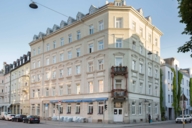
Schwabing, Kunstareal, Haidhausen or Giesing? Immerse yourself in the district of your choice together with an official guide and learn exciting background information and anecdotes!
You can experience just how colorful Munich is in its more than twenty neighborhoods, each with its own unique character. And that's exactly what the new Viertelliebe tours are all about: exploring the special features of each neighborhood together. No matter which district you choose, on all tours our guides not only impart historical and art-historical knowledge – they also provide moments of encounter with the Munich residents who live in the districts.
In the Old Town, our guide will not only take you to the classic sights, but will also let you in on the shopping rituals of the people of Munich: From the favorite cheese stand at the Viktualienmarkt to the final prosecco and appetizers at Dallmayr. With the Kunsthalle (art gallery), numerous theaters and the Literaturhaus (literature house), the old city also boasts a high density of cultural temples. Contrasts coexist with the greatest of ease: just around the corner from the Nationaltheater (opera house) stands....the Hofbräuhaus.
If you walk from the old town across the Viktualienmarkt and Blumenstrasse, you automatically end up in the hip Gärtnerplatz- and Glockenbachviertel districts with their small boutiques and colorful LGBTQ* scene. Here, stories entwine around Freddie Mercury, among others, who spent a few years of his life here.
Alternatively, a local-love tour of the bustling multicultural district around the main train station, with its pyramids of baklava and lush fruit and vegetable stalls. The southern station district is a melting pot: Turkish supermarkets, Indian specialty restaurants, hip design offices, young artists and galleries coexist here and show: Munich is not only a cosmopolitan city with a heart, but also a city of the world.
Going up the Isar, one enters new tourist territory in the Schlachthofviertel district, where a fresh cultural scene has grown in the wake of the migration of the animal trade and meat production. Here, in the city's unofficial celebration district, the new Munich Volkstheater also opened in 2021. In addition, temporary use projects such as the container city “Bahnwärter Thiel“, the café ship on the bridge, the Alte Utting and the Hall of Fame with graffiti worth seeing on Tumblingerstrasse are growing and flourishing.
Trains, small rivers, flowers, evening sun – beer. If you can put these five terms in a romantic context, you've come to the right place: the former working-class district of Giesing. Giesing, in turn, borders on Haidhausen, where everything is quite different again, more alternative perhaps, less wild. The best thing to do is to visit both neighborhoods as part of a guided tour of Viertelliebe and see for yourself.
Of course, Schwabing, probably Munich's most historic quarter, should not be missed. It was already a city when it was incorporated into Munich in 1890. The Schwabing bohemian scene was legendary. Of course, the neighborhood has changed, yet many (life) artists still live here, such as Rainer Langhans, the writer Patrick Süskind and the filmmaker Doris Dörrie.
In Schwabing's neighboring district, Maxvorstadt, with its two universities and the Kunstareal, all signs point to world-class museums and science. Maxvorstadt is also architecturally interesting, as it was the first neighborhood to be built outside the medieval city fortifications.
The 1972 Summer Olympics, 1970s architecture, the Olympic assassination – these are the topics on a tour of the Olympisches Dorf (Olympic Village), where the athletes were housed during the Games. The Olympiadorf with its apartment blocks and brightly painted bungalows was considered an urban planning experiment in 1972 and has been under ensemble protection since 1998.
Also on offer is a quarter-love guided tour of Neuhausen-Nymphenburg. With your guide you will stroll through the streets with their nice little stores, cafés and restaurants around Rotkreuzplatz. The neighborhood impresses with its spacious parks and beer gardens and its proximity to the castle. In the vicinity of the driveway avenues are villas from the Wilhelminian period and not far away you will visit the Herz-Jesu-Kirche (church), an outstanding example of contemporary architecture.
Key data of the guided tours:
Schwabing: 24-Hour Kiosk Münchner Freiheit Glass Cube (Münchner Freiheit 7, 80802 Munich) or by arrangement
Schlachthofviertel: In the inner courtyard of the Volkstheater (Tumblingerstr. 29, 80337 Munich) or by arrangement
Haidhausen: Wiener Platz (81667 Munich) at the maypole or by arrangement
Glockenbachviertel: Gärtnerplatztheater (Gärtnerplatz 3, 80469 Munich) or by arrangement
Kunstareal: In front of Café Ella at the Lenbachhaus (Luisenstraße 33, 80333 Munich) or by arrangement
Giesing: In front of the main entrance of the Heilig-Kreuz-Kirche (Gietlstr. 2, 81541 Munich)
Neuhausen-Nymphenburg: In front of the main entrance of Galeria Kaufhof at Rotkreuzplatz (Pötschnerstr. 5, 80634 Munich)
Südliches Bahnhofsviertel: At the head of platform 11 at Munich Central Station (Bayerstr. 10a, 80335 Munich) or by arrangement
Olympic Park and Olympic Village: In front of the kiosk at the overview board of the three memorial sites at the underground exit ‘Olympiazentrum’ (north exit: Olympic Village) or by arrangement
If you would like to make a binding booking for this tour with München Tourismus, please send your booking request with the following details by e-mail to: tourismus.guides@muenchen.de
You will receive the booking confirmation by e-mail once a guide has been arranged. You can download an overview of our tour guide fees as well as our terms of payment and cancellation here:
Prices and conditions for guided tours 2025 as PDF for download
If you have any further questions, our colleagues from the tour guide agency will be happy to help you.
Phone: +49 89 233 30234
E-mail: tourismus.guides@muenchen.de